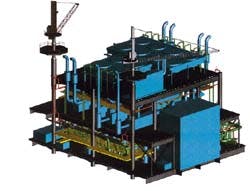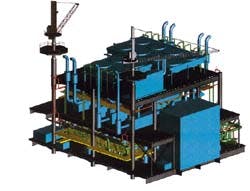Construction industry thriving as US majors move into West Africa
Mobil's Ekpe Field will be developed by three bridge-linked platforms.
Africa has been a happy hunting ground for French offshore engineering contractors, thanks largely to historical associations. Elf Congo's N'Kossa project provided a windfall for the big two, ETPM and Bouygues Offshore, but the West Coast development scene has lately become more competitive.
Elf has eased back on new projects in the area, preferring to concentrate on N'Kossa, where further discoveries continue to be made. The current leading lights are a trio of US majors, Chevron, Mobil and Texaco, which encourage aggressive contract pricing. This has opened the door for Far Eastern yards.
Nevertheless, ETPM and Bouygues Offshore still feature in 80-90% of the new contracts being awarded off West Africa through their respective links with McDermott and Saipem.
ETPM
Between them, McDermott and ETPM can offer a spread of pipeline and platform installation vessels as well as fabrication yards in the Gulf of Mexico, UAE, Gabon, and Nigeria - all for projects offshore West Africa. As elsewhere in the world, West African governments are pressing for increasing local content in the construction process.
McDermott-ETPM West has responded by taking on more staff at its Warri, Nigeria yard where a workforce of 500 will be maintained until at least mid-1997. In January, the joint venture also opened a base in Luanda. Scope of its activities are currently being defined: it is only a commercial representative office currently, but will likely be developed for pre-fabrication or light construction duties.
"With peace established in Angola, we don't want to miss the opportunity to be one of the first companies to operate there with oil companies," says Philippe Becci de la Riviere, the company's commercial manager for Angola.
The joint venture's most recent success in this country was a Fr400 million contract from Chevron for the Cabinda Area B development. This involves transport and installation (with three lift operations) of two platforms for the Nemba South Field.
Earlier this year McDermott-ETPM West barge DLB Polaris completed several transport and installation jobs for Elf in Angola, including the installation of the Cobo jacket and other minor lifting and hook-up work for the IPS-F1 platform on the Impala Field.
For the immediate future, however, Nigeria offers the best prospects of work. The venture's current main contract (worth Fr600 million to ETPM) involves building, transporting and installing two platforms for Mobil's Ekpe Field.
One is a 5,000-ton gas compression platform, OY, plus six piles weighing 1,650 tons in total. The other (OQ) weighing 2,600 tons, including piles, will be bridge-linked to OY. McDermott's Morgan City, Louisiana yard is building the decks with Warri handling the jackets.
The joint venture will also renovate the existing platform Ekpe OP - mainly fitting new piping and electrics and a new control room. DLB Polaris is booked for installation of the platforms in spring 1997.
McDermott-ETPM West has also put its name down for Elf Nigeria's Ofon project, which initially calls for one main production platform and two bridge-linked wellhead platforms. If the bid is successful, Warri would build the jackets with Jebel Ali managing the decks. Polaris would also install infield oil and water injection flowlines, as well as the 41 km export pipeline to Elf's Odudu facilities.
The joint venture barges CBL 101 and PL6 are currently involved in contracts with Chevron for pipelay work and platform upgrades in the Escravos area.
Finally, Texaco is likely to issue tenders shortly for mid-size developments for its Anyala, Chioma, and Madu oilfields off Nigeria.
One of the aforementioned developments will provide a debut for ETPM's Smart Leg technique. This allows a heavy deck to be transferred from a conventional barge directly onto a fixed jacket in a shockless operation, even in a 1.8-meter long swell.
Typically, the jacket is designed in a U-shape to receive the barge. Once in position, the deck's heavy seafastening is removed and the deck is then raised by the barge buoyancy. The deck load is next transferred, when in its upper position, to the jacket leg using Smart Leg. Subsequently, the barge is released through further ballasting and retraction of supports. Finally, the deck is leveled through controlled lowering of the jacks on their rams using the deck's own weight.
The technique may also be adapted with the moving jacks installed not inside but on top of the deck legs - supposedly making the operation more efficient and easier - with an extension pipe between the jack rod and the jacket inside the deck legs. (Jacks are independent of leg size).
Bouygues Offshore
Last July, Bouygues Offshore and Saipem established Saibos to offer joint construction and turnkey installation of platforms and pipelines off West Africa and South America. Assets include the Castoro 8 dsv and pipelay barge, the BOS 230 hook-up barge and various other transportation vessels.
The Saibos partners do not operate any yards jointly, but their own yards can be included in an EPIC bid (as can fabrication sites anywhere in the world). When installation is not involved, however - only construction - Bouygues Offshore bids independently.
Before Saibos was established, the company clinched a $648 million contract from Mobil Nigeria for the Oso Field NGL recovery project. As part of a consortium with ABB Lummus Crest and JGC, Bouygues Offshore's responsibilities include:
- Fabrication and installation of three platforms and associated bridges (with construction performed at the Nissco yard in Nigeria).
- Supply and installation of pipelines: Oso is located 48 km southwest of the Eket terminal.
Saibos' current West African workload includes jacket and pipeline installations for Agip's Kitina Field in the Congo, and a turnkey installation job for three platforms for Mobil's Usari Field in Nigeria, valued at $170 million.
It is also working for Texaco in Angola's offshore Block 2. Several fields here are being brought onstream that were delayed by the civil war. New wellhead platforms are being installed on Lombo North, Cavala, Bagre, and Estrela.
Eiffel
The 10,000-ton Cobo integrated production deck left Eiffel's yard in Fos, France last December for Angola. It also left the company without any new offshore construction orders, although it is targeting future Elf projects in West Africa.
In this region, semisubmersibles and production jackups are not being overlooked in favor of production ships, and Eiffel has several designs that may be relevant. These include the deepwater TH4200 semisub, designed on the same configuration as the four TH2800 units operating for Petrobras for nearly a decade. The TH4200 platform offers a total deck area of 7,000 sq meters and operating payloads up to 12,000 tons for drilling or production.
Eiffel's new minimum facilities jack-up is intended as a low cost development solution which avoids the need for heavy lift vessels. It can be fully commissioned at the yard, with operating payloads up to 4,550 tons.
As well as Fos, Eiffel is establishing local partnerships with companies in Morocco, Thailand and the US to provide local fabrication and heavy lift service.
Copyright 1996 Offshore. All Rights Reserved.

